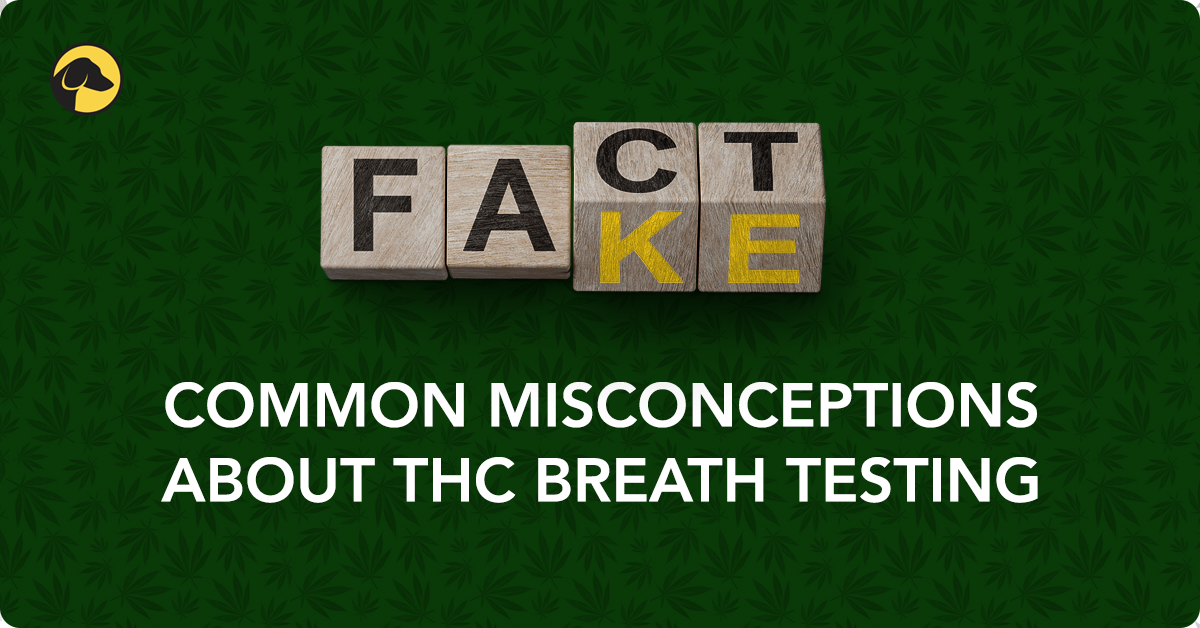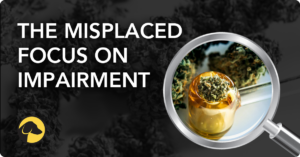
The Truth About Cannabis Breath Testing Misconceptions
Like many new technologies, cannabis breath testing has garnered a lot of attention and inquiries from the market. Our test introduces a new sample type (breath), a new cannabis detection window (only recent use), and a new scientific approach (measuring in parts per trillion) to the drug testing industry. The novelty of this solution even helped coin a new classification of a THC test: methods that can identify recent cannabis use associated with the workday.
While the groundbreaking science and technology behind cannabis breath testing has captured the attention of many, it’s understandable that some misconceptions have emerged. But misinformation doesn’t only mislead; it can have expensive and unintended consequences. Here, we work to separate fact from fiction related to common misconceptions about cannabis breath testing.
MYTH: CANNABIS BREATH TESTING ISN’T A PROVEN METHOD
The HOUND® CANNABIS BREATHALYZER is designed to meet standards set by lab instrumentation with tight tolerances and consistent, accurate results. The latest breath testing studies conducted in 2023 confirm the solution can detect psychoactive THC in the breath almost immediately after smoking and for approximately two to three hours thereafter. Clinical study results also show that the test is specific enough to isolate detection of active THC molecules. These study results satisfy significant market demand for a solution that can determine if an employee has used THC during the workday.
For ten years, Hound Labs has rigorously tested its technology to evaluate and validate the accuracy, sensitivity, and specificity of the solution. Researchers have conducted tests in the laboratory, in the field, and in clinical studies. These latest findings continue to support the performance and reliability of breath testing as a reliable measure of recent cannabis use.
MYTH: DRUG TESTS ARE EASY TO CHEAT
It only takes a quick internet search to find countless tips and tricks claiming to help cannabis users beat a drug test. Drug test cheating is such a problem that many states have enacted legislation that makes it a criminal offense to cheat a drug test, but it still happens. Some test types make it easier to get away with cheating, but breath is not one of them.
Urine testing is the most popular drug test type and given the nature of its typically private collection process, it’s also one of the easiest test types to cheat. There are three main methods of cheating a urine test. Dilution involves consuming as much liquid as possible so there aren’t enough drug metabolites in the sample to render a positive result above the cutoff level. Adulteration occurs when a substance is added to the sample to lower or mask the presence of drugs. Substitution occurs when a person uses synthetic urine or a “clean” sample provided by someone else.
Breath, hair, and oral fluid drug test samples are typically collected in an observed setting, making them far more difficult to cheat by any of the dilution, adulteration, or substitution methods outlined above.
Specifically in the case of cannabis breath testing, we’ve heard about extreme instances such as vomiting, exercising, showering, or causing hyperventilation to help thwart the test. Not only are some of these suggestions dangerous, but they are also ineffective against the Hound® solution. Breath testing utilizes observed collections, placing donors in the presence of a test administrator throughout the entirety of the collection. This approach helps ensure the integrity of the collection from start to finish.
Sample contamination is also highly unlikely with breath testing. The heavily tested HOUND® CANNABIS BREATHALYZER captures molecules from the lungs, where THC remains present for only a few hours after use. In contrast, THC in oral fluid originates from contamination in the oral cavity (mouth) and remained detectable for up to 72 hours in some studies.
MYTH: CANNABIS BREATH TESTING MEASURES IMPAIRMENT
This answer is straightforward. No cannabis test in the market today can detect impairment. In fact, no drug test is capable of measuring impairment for any drug.
The HOUND® CANNABIS BREATHALYZER provides employers with the next best thing. The solution determines whether an individual used cannabis within the last two to three hours. A cannabis breath test can help employers identify recent use that has the potential to negatively impact an employee’s performance and increase exposure to safety incidents, reputational risks, and additional operational costs.
Part of the confusion around testing for an impairment standard comes from an attempt to make a direct comparison between alcohol and THC. Research conducted over decades shows that, on average, alcohol follows an established post-consumption metabolization pattern. Because of this, states can rely on per se laws that make it illegal in and of itself to operate a motor vehicle at or above the established Blood Alcohol Content (BAC) level, regardless of whether or not the driver exhibits visible signs of impairment or safety-impacting behaviors.
That same standard does not exist for cannabis at this point, and its classification as a Schedule I drug has prevented some of the research necessary to determine whether there will ever be a quantitative standard under which a user would be considered impaired.
“The people drafting legislation that includes language [about identifying cannabis impairment] may be thinking of it like alcohol, and there’s a legal, per se, limit for alcohol,” says Dr. Barry Sample, a leading workforce drug testing expert and Hound Labs science advisor. “So, why can’t they do the same thing for cannabis? Well, we know that the science and the technology just aren’t there to support that same determination.”
MYTH: IT’S TOO EXPENSIVE
According to the National Safety Council, employers spent $167 billion on workplace injuries in 2021. Another study by the National Council on Alcoholism and Drug Dependence estimates annual expenses of $81 billion stemming from absenteeism and lost productivity, turnover and recruitment costs, and accident-related expenses tied to substance use.
Drug testing return on investment (ROI) used to be easy to calculate. For employers with zero-tolerance policies, positive drug tests were grounds for firing an employee or not hiring a candidate. Cannabis legalization and widespread use are changing the model because in many cases, employers can no longer afford the candidate and employee losses resulting from zero-tolerance policies that leverage legacy drug testing methods with long windows of detection.
THC breath testing, on the other hand, deters recent use and helps accelerate the cost savings associated with testing by allowing employers to continue reaping the benefits of drug testing while also maintaining fair workplaces. This new ROI model reinforces the ultimate goal of drug testing, which is a zero percent drug test positivity rate, not a zero-tolerance program. It’s a new way to think about ROI where negative – not positive – results demonstrate the value of a cannabis testing program.
A cannabis breath test helps employers retain employees whose off-the-job cannabis use may not impact workplace safety or performance but could otherwise trigger positive oral fluid, urine, or hair drug test results. Limiting positive results to only those employees who used within a few hours of the breath test helps retain employees, creates a larger candidate pool for open positions, and communicates a focus on equity and fairness to employees who are at a premium in today’s tight labor market.
Calculate your business’s breath testing ROI with our Employer Cost Savings Calculator.
MYTH: CANNABIS BREATH TESTS AREN’T USEFUL FOR PRE-EMPLOYMENT TESTING
Failing to test potential employees for cannabis use puts the company – and its bottom line – at risk. Even as states implement varying laws tied to drug use, pre-employment drug testing remains broadly legal. New York is the only state that prohibits testing some applicants specifically for cannabis during pre-employment.
Even in California and Washington, where new laws provide some employee protections for off-duty cannabis use, most employers can still test applicants for cannabis using a breath test that detects active THC molecules rather than its metabolites. This means breath testing is a viable option in those states.
THE TRUTH ABOUT CANNABIS BREATH TESTING
Don’t put your organization at risk by believing the misconceptions about cannabis breath testing. It’s proven, available, and legal.
If you would like more information about the Hound® solution, our experienced team of experts is here to help.

January 25, 2024
By LOUISA ASHFORD
Director of Marketing
Share











